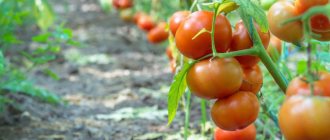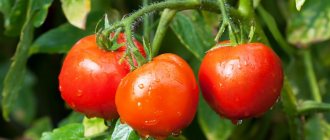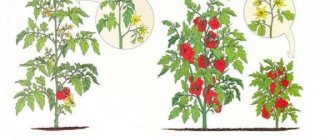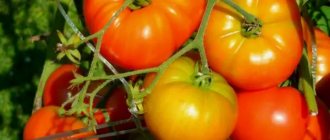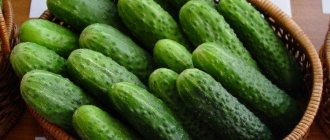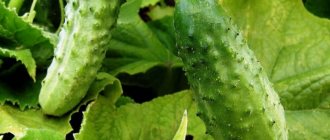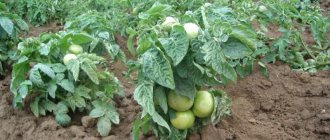Eggplant Clorinda F1 is a mid-early Dutch hybrid with consistently high yields and large fruits of a classic dark purple color. Let's find out what is remarkable about this hybrid variety and what are the features of its agricultural technology.
Eggplant Clorinda tolerates adverse weather conditions
Eggplant Clorinda has a small number of seeds
Eggplant Clorinda
Description of culture
Clorinda F1 is an early-ripening universal hybrid obtained by Dutch breeders. It grows equally successfully both under shelters and in open ground.
The Dutch hybrid "Clorinda" is included in the State Register and is suitable for cultivation in all regions of Russia.
Short description:
- Bush. Semi-spreading, erect, reaches a height of 70-80 cm. Under the film it grows up to 90 cm. The stems are purple, pubescent, with short internodes. The leaves are medium sized, with serrated edges.
- Fruit. Shape: oval or oval-pear-shaped. The color is dark purple, the skin is glossy. The length of the fruit is 12-20 cm. The pulp is white, dense, and practically does not contain seeds.
Main characteristics of the hybrid "Clorinda":
| Characteristics/parameters | Description/meaning |
| Ripening time | 110 days pass from the day of planting to ripening |
| Productivity | 2.2 kg per 1 sq. m – in open ground, 3.2-6 kg – in a greenhouse |
| Fruiting | Long-lasting, bears fruit until frost |
| Fruit weight | 250-300 g, maximum – 1 kg |
| Taste | No bitter aftertaste |
| Application | Universal |
| Disease resistance | High, there is immunity to tobacco mosaic |
| Resistance to adverse conditions | High, tolerates cold weather well |
Description of the fruits of the Clorinda F1 variety
The Clorinda eggplant produces pear-shaped fruits with shiny, dark purple skin. Their diameter can be up to 25 cm. The maximum weight declared by the manufacturer is 1.5 kg. This is hard for many gardeners to believe. Reviews of Clorinda eggplant are especially often accompanied by enthusiastic exclamations about the unusual qualities of the fruit. The pulp of this vegetable is truly distinguished by its dense structure, attractive white color and the absence of seeds. It darkens slowly and has excellent taste. In most reviews of the Clorinda eggplant, with photos of the harvest, the average weight of one fruit is approximately 400 g, and the diameter does not exceed 10 cm. It is rare that the ovaries reach the stated weight, but this also happens with proper care and suitable conditions. The variety is resistant to the tobacco mosaic virus, tolerates stressful situations well and is quite cold-resistant. The Clorinda eggplant in the photo resembles a dark, shiny pear, with an even skin texture and a glossy sheen.
Advantages and disadvantages of the variety
The numerous advantages of the Clorinda variety allow gardeners to turn a blind eye to some of its shortcomings.
Pros:
- able to grow in temperate climates;
- withstands adverse weather conditions;
- delicious fruits;
- high and stable yields;
- there are few seeds in the pulp;
- can grow in open ground, in greenhouses and greenhouses;
- high immunity, especially resistant to viral diseases;
- long fruiting;
- bushes require almost no shaping.
Minuses:
- seeds are expensive;
- It is impossible to collect seeds yourself, since hybrids do not pass on their varietal properties to subsequent generations.
Area of application of fruits
The collected fruits are used to prepare various dishes and snacks, salted, pickled, and canned in various eggplant salads for the winter. You can also cut the fruits into pieces and freeze them in the freezer.
Growing Clorinda seedlings
Eggplant "Clorinda" is recommended to be grown by seedlings. Sowing seeds in the ground is possible only in the south of Russia, since tender seedlings do not tolerate sudden temperature changes and cold snaps.
Optimal timing
Seedlings are usually grown at home. The sowing time is determined by counting two months from the expected transplant date. Eggplant seedlings grow in 60-75 days, and if the weather does not allow planting them on time, there will be another half month left.
Eggplant seeds are sown for seedlings from late February to mid-March.
Soil selection and preparation
Soil for planting is purchased at an agricultural store. This substrate has a balanced composition and contains all the nutrients necessary for growth. Seedlings planted in a purchased substrate do not need additional feeding - they have enough nutrition until planting.
If it is not possible to purchase a substrate, prepare a soil mixture by mixing:
- peat – 6 parts;
- sand – 1/2 part;
- compost – 2 parts;
- turf – 1 part.
The soil for seedlings can be prepared in advance - in the fall. Store it at temperatures below 0 °C.
Freshly prepared soil mixture must be disinfected by calcination before planting. It is placed in the oven - spread in a layer of 5 cm, and the temperature is turned on +70...+90 °C, no more.
After calcination, the soil is completely disinfected, but needs to be restored - it is allowed to rest for 2-3 weeks before sowing the seeds.
Seed preparation
Eggplant seeds are sold ready for sowing - they have already been processed and disinfected. If there is no processing mark on the package, you will have to do it yourself.
Preparing seeds for sowing:
- Disinfection. Immerse the seeds in a 1% solution of potassium permanganate for 20 minutes.
- Stratification. Place the disinfected seeds in hot water (+50 °C) for 30 minutes.
- Stimulation. Immediately before planting, soak the seeds in a growth stimulator, for example, Epin. As a stimulant, many gardeners use aloe juice or 3% hydrogen peroxide heated to +40 °C. The seeds are soaked in aloe for a day, in peroxide for 10 minutes.
Sowing seeds
Seeds are sown in containers that are disinfected and filled with soil. For planting, it is most convenient to use cassettes or individual glasses, as they avoid the picking stage.
A less desirable option is sowing in containers. The seeds are sown densely, and when two cotyledon leaves appear, they are planted in larger containers.
Sowing seeds in individual containers:
- Moisten the glasses filled with soil.
- Plant 1-2 seeds in each glass. Place the seeds in the center of the glass and deepen them 1 cm.
- Sprinkle the seeds with soil and cover the crops with transparent material to create a favorable microclimate for them.
- Place the crops in a warm place. The optimal temperature is from +25 to +28 °C.
- Ventilate the crops daily to remove condensation that accumulates on the film or glass. Water the soil as it dries - it is strictly forbidden to over-water it.
- Shoots will appear in 10-15 days from the crop field. When this happens, remove the film or glass cover and move the seedlings to the brightest place.
According to reviews, “Clorinda” has 100% germination rate, so it is more rational to plant only one seed, since the second sprout will still have to be pinched.
Seedling care
To grow strong, healthy and viable seedlings, you must not only take care of them - water and feed them, but also create favorable growing conditions - temperature, light, etc.
Features of caring for Clorinda seedlings:
- Temperature. Within 2-3 days after the first shoots appear, the daytime temperature is reduced to +16 to +18 °C. Then it is raised again to +24...+25 °C. The night temperature is maintained at +14…+15 °C. Seedlings should receive an influx of fresh air, but drafts are not allowed.
- Lighting. The optimal length of daylight for "Clorinda" is the same as for all eggplants - 12-14 hours.
If necessary, seedlings are illuminated using phytolamps or fluorescent lamps. They are turned on in the mornings and evenings. If the weather is cloudy, then the lamps are turned on during the day. The distance from the lamps to the seedlings is 30-50 cm. The duration of illumination should not be more than 14 hours, otherwise the plants will begin to grow green mass and will not produce ovaries. - Watering. Water the seedlings moderately, and only at the root. Sprinkling is not acceptable for eggplants. When watering the seedlings, maintain a moisture balance, avoiding drying out or waterlogging.
- Picking. Seedlings sown in containers in rows need picking. It is transplanted when the seedlings form 1-2 true leaves. Seedlings are planted into individual containers. Before picking, moisten the soil so that the seedlings are easier to remove from the soil.
- Feeding. The seedlings are fed for the first time 2 weeks after emergence. If the seedlings are picked, then fertilizing is carried out 2 weeks after the picking. How to feed seedlings:
- First feeding. You can feed with potassium nitrate (30 g per 10 liters of water) or Kemira-Lux (20-30 g per 10 liters of water). Another option is to dilute ammonium nitrate (5 g), superphosphate (15 g), and potassium sulfate (10 g) in a bucket of water.
- Second feeding. You can feed it with organic matter. It is applied 10 days after the first feeding. You can prepare a solution of chicken manure. To do this, mix the infusion of litter with water in a ratio of 1:15.
- Third feeding. A week before planting seedlings, they are fertilized with superphosphate and potassium salt. 70 g and 30 g are dissolved in 10 liters of water.
- Hardening. 10-14 days before transplanting into open ground, seedlings begin to be gradually hardened by taking them outside for a short time. Gradually, the time of “walks” is increased, bringing their duration to several hours. Thanks to hardening, seedlings get used not only to temperature changes, but also to direct sunlight.
Care
Eggplant is an unpretentious crop, so care can be minimal. The main thing is not to forget about fertilizing and regular watering.
See also
Is it possible to plant eggplants in the same greenhouse with cucumbers, how to grow and care for them
Read
Watering and soil care
Once a week you should loosen the soil and remove weeds from the garden bed. It is best to weed the soil before watering so that the roots receive oxygen along with the water. Irrigate the soil every day, in the evening after sunset. For irrigation, water heated in the sun is used. If you use cold water, the eggplants may begin to suffer from fungal diseases.
Top dressing
After transplanting to a permanent place, fertilizers are applied to the soil after 10 days. Nitrogen is used as fertilizing. Nitrogen-containing fertilizers promote plant growth.
After the plants enter the flowering and fruiting phase, they are watered with phosphorus-containing and potassium fertilizers.
They are alternated with the addition of rotted manure and watering with infusion of weeds.
Spraying against pests and diseases
As a preventive measure, a few weeks after planting, eggplants are sprayed with a solution of Bordeaux mixture. Spraying with “Fitosporin” or the drug “Uniflor-micro” helps against tobacco mosaic.
Another disease is bacterial spot. Fitosporin-300 will help you cope with it. If the disease is advanced and many bushes are damaged, then they are all dug up and destroyed, and the beds are then treated.
Insects are rarely found on eggplants, except for the Colorado potato beetle. If there are few insects in the beds, they are collected by hand. If there is a lot, they are sprayed with chemicals against the Colorado potato beetle. But it is better to do it manually so that the chemicals are not absorbed into the fruits.
Bush formation
Eggplants do not need to form a bush. The only thing is that as the bushes grow, you can tear off the lower leaves. Also, you need to leave three of the healthiest shoots on the bush, and cut off the rest.
Growing in open ground
Eggplants are planted in open sunny areas with well-drained fertile soils. Recommended acidity – slightly acidic soil (pH from 6.3 to 6.8).
Areas where nightshade crops were previously grown - potatoes, peppers, tomatoes, eggplants - are not suitable for planting.
Transplanting seedlings to a permanent place
Seedlings with 8-10 leaves are planted in the ground in mid-May, in previously prepared soil. In the fall, manure or humus is added to it and dug up.
Before planting, the soil is prepared by adding organic fertilizers. Rotted manure is added - 0.5 kg per 1 sq. m. m, or store-bought complex fertilizers with a ratio of nitrogen, phosphorus and potassium of 1:2:1.
The procedure for planting seedlings in the ground:
- Prepare holes 20-25 cm deep. The roots of the seedlings along with a lump of earth should comfortably fit in them. The intervals between neighboring plants are 30 cm, between rows - 40-50 cm.
- Water the holes with a weak solution of potassium permanganate. Pour 500 ml of solution into each hole.
- Carefully remove the seedlings from the glasses. To make seedlings easier to remove, water them 2 hours before transplanting with warm, settled water.
- Place the seedling in the hole and gently cover the roots with soil. Gently compact the soil with your fingers and water the plantings.
- Mulch the plantings with dry soil or humus - it will retain moisture in the substrate, which will reduce the frequency and rate of watering.
Watering
Eggplants are watered early in the morning with warm, settled water. The optimal water temperature is +24…+25 °C. Watering eggplants is carried out as the soil dries out - about once a week. The frequency of watering is increased during dry periods and during fruit filling.
After the water is absorbed, the soil is loosened - under the bushes and between the rows, trying not to damage the plant roots located close to the surface. It is recommended to hill up eggplant bushes.
Top dressing
Fertilizers are applied 4-5 times during the season. It is recommended to fertilize every two to three weeks.
Feeding order:
- Fertilizers are applied for the first time after rooting of seedlings. You can add a complex drug.
- Every two weeks, the plantings are watered with fermented herbal infusion. When the fruits ripen, complex fertilizer is added to this feeding.
Feeding options:
- dilute 1 liter of slurry in 15 liters of water;
- mix potassium sulfide (5 g), urea (10 g), superphosphate (10 g), wood ash (250 g) and dissolve them in 10 liters of water;
- prepare a 3% boric acid solution for foliar feeding during flowering;
- dissolve 20 g of ammophoska in 10 liters of water.
Formation of bushes
Shaping in the form of pruning and pinching is perceived by the bushes as stress, so its implementation is not necessary. The procedure is carried out to obtain a compact bush.
Formation rules:
- the procedure begins when the height of the bush reaches 25 cm;
- 4-5 strong side shoots are left, all others are cut off with pruning shears;
- stepsons are removed in a timely manner;
- regularly pick off yellowed leaves, as well as underdeveloped and damaged fruits;
- It is recommended to tie the “Clorinda” bushes to trellises or other supports.
Diseases and pests
Possessing immunity to tobacco mosaic, the variety can be affected by various fungal and bacterial infections:
- blackleg;
- various rots;
- Colorado beetle;
- whitefly;
- cruciferous flea beetle;
- spider mite
Fighting methods:
- Insecticides are used against insects - “Fitoferm”, “Aktaru”, etc.
- Disinfection of seeds before planting.
- When signs of disease appear, plants are sprayed with Zircon, Trichodermin or Fitosporin.
- To prevent diseases, sprinkle the soil with bleach or wood ash.
- Spraying dry kaolin clay helps prevent cruciferous flea beetles.
Collection, storage and use of fruits
Eggplant harvesting begins approximately 90 days after sowing, when the fruits reach technical ripeness. It is judged by color - the fruits should turn dark purple, and by size - the length of the eggplant should reach 12-20 cm.
Rules for harvesting and storing crops:
- The fruits are cut with pruning shears.
- The fruits should not be allowed to overripe - they become bitter.
- Picked fruits can be stored in the basement or in the refrigerator, wrapped in paper or film. The fruits are stored for 2-4 weeks.
Harvesting and storage
With proper planting and regular care, you can try homemade eggplants from mid-summer, even in central Russia. Ripe fruits are cut from the bushes with a knife or pruning shears, while the stalk remains on the fruit, only the shoot is cut off.
The fruits are harvested at least once every 2-3 days; you cannot leave an already ripe harvest on the branches - it will become overripe, and the eggplants themselves will lose their elasticity and begin to wrinkle.
Vegetables are stored in the refrigerator on a separate shelf from other products or in the cellar. Suitable for harvesting a closet, basement, or any dark and cool place in the house. Eggplants can last from 4 to 8 weeks.
Features of cultivation and possible difficulties
If you do not know the intricacies of growing “Clorinda”, or violate the agricultural practices of the variety, troubles will inevitably appear in the form of diseases or reduced yields.
What you should pay attention to:
- The variety grows well in any soil - open and closed; it can be planted in a greenhouse 2-3 weeks earlier. In a greenhouse, you can do without growing seedlings by sowing seeds directly into the beds.
- When growing Clorinda, it is important to prevent excessive soil moisture, and when growing under cover, it is necessary to control the moisture content not only in the soil, but also in the air. With excessive moisture, the variety is prone to fungal infection.
- The variety needs regular feeding. With a lack of nutrition, the fruits become smaller and the number of ovaries is reduced. It is necessary to feed the plant at least 5 times after planting in the ground.
The gardener will tell you about his experience of growing Clorinda in the following video:
Diseases and pests
According to the description, the Clorinda variety has high immunity to both viral and bacterial diseases. If not properly cared for, fungal damage occurs, which occurs when the soil is excessively waterlogged.
To prevent occurrence, disinfect seeds before planting. If lesions were found on adult specimens, treat the bushes with Zircon or Fitosporin.
In rare cases, aphids, spider mites, and slugs appear on plants. To combat such pests, treat with Karbofos or Keltan. Tobacco dust and wood ash are effective folk remedies. They are sprayed on bushes to repel pests.
Eggplant KLORINDA F1, description, growing experience.
Sowing eggplants Epic and Clorinda. Dutch selection.
Antifake. Part 37. Eggplant seeds Clorinda F1 from Seminis
Bushes can be affected by diseases:
- blackleg. To prevent this, treat the soil with wood ash and bleach;
- various types of rot. Treatment with fungicides helps to cope with them;
- viral. To avoid infecting healthy bushes, affected plants must be removed.
Possible pests:
- aphid;
- spider mite;
- Colorado beetle;
- whitefly
After the ovaries appear, chemical treatment is prohibited.
The most important pest for this crop is the cruciferous flea beetle, which manifests itself with many tiny holes on eggplants. To avoid this problem in open ground, dry kaolin clay is sprayed onto the plants.
Infected eggplants are treated with an appropriate insecticide (Actellik). American private farms growing eggplants in containers can share a unique way to combat the pest: a distance above 20 cm from the ground becomes insurmountable for the pest. And the flea simply does not get into the containers.
A very aggressive pest is the Colorado potato beetle. An effective way to combat it is to manually collect and destroy the eggs found, as well as spraying plants with Prestige or Sonnet preparations.
Eggplants are susceptible to mildew and verticillium wilt, but resistant to mosaic virus. Excellent ways to prevent these diseases are a sunny location, regular (daily) watering of the root zone and enough free space for air circulation around each bush.
If the plants are still infected, then treat them with fungicides (Trichodermin, Fitosporin), according to the instructions on the package.
Reviews from gardeners
★★★★★
Konstantin, 56 years old, amateur gardener, Pskov region. It’s not easy to grow eggplants here – the weather is not favorable.
But the Clorinda variety grows well. I planted it under film, on average the fruits grew 500 g. The taste is excellent, the fruits store well for a month. ★★★★★
Olga, 49 years old, housewife, Bryansk region. Our eggplants grow well even without film.
I plant them at the dacha at the end of May, mostly early varieties. Clorinda F1 manages to ripen even in cool summers, and its fruits taste excellent. Hide
Add your review
Eggplant Clorinda F1, having a short growing season, manages to ripen not only in the south, but also in regions with short and cool summers. The hybrid is quite demanding, it needs regular watering and fertilizing, but it can withstand weather troubles and please gardeners with stable harvests.
0
0
Copy link
Eggplant Clorinda variety description
This is a tall plant: the height of the stems reaches 1 m. The variety is mid-early; approximately 68 days pass from fruit set to full ripening. The yield per 1 m2 is approximately 6 kg. The vegetable forms many ovaries and has a long fruiting period. The full name of this eggplant variety is Clorinda F1. This means that the plant belongs to the first generation resulting from crossing several varieties. Hybrid varieties are often much more expensive than regular varieties due to the small amount of seeds produced from the mother plant. But the result of the painstaking work of breeders and agronomists is usually much more resistant to diseases and pests, less exposed to stress and more cold-resistant than simple representatives of this vegetable crop. It is only impossible to propagate plants by seeds at home, while preserving varietal characteristics.
